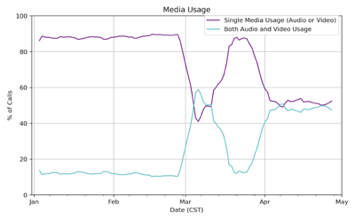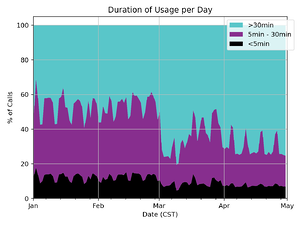How COVID-19 Impacted North American Communications Behavior

The global pandemic caused by the COVID-19 virus has caused millions of people around the world to experience an unprecedented change in their daily routines. Like many countries, local governments across North America responded to the pandemic by enacting a shelter-in-place (ShIP) order and encouraging social distancing to reduce the community spread of the virus. Physical distancing has changed the way we communicate on a day-to-day basis and we have become more reliant on various forms of electronic communications, such as audio and video conferencing.
We analyzed billions of calls to measure the changes to usage behavior, call connectivity, and call quality in North America over a 4-month period. For this report, we are specifically looking at the trends from audio and video conferencing calls, between January 1 to April 30, 2020, from Continental North America, San Francisco Bay Area, and East and West Coast of the United States. For the analysis, we are using data from customers that were already sending data in January and February and excluding all customers that we started collecting data from during the pandemic. This removes any bias in the data from the new apps, use-cases, and only shows the changing dynamic for existing applications and services.
As the pandemic grew rapidly during Jan and Feb, many states responded by declaring a state of emergency during the first weeks of March[1],[2] and a national emergency was declared on March 13[3]. This drew more attention from the public and consequently many companies, organizations, and schools began planning on how to adapt. Figure 1.1. shows that most US states issued Shelter-In-Place (ShIP) orders that came into effect around the latter half of March. However, many companies and organizations, especially in the Seattle Area and Bay Area, started encouraging their employees at the beginning of March to work remotely from home (WFH), a few weeks before the Shelter-In-Place (ShIP) directives were imposed. Hence, the month of March can represent the transitional period to ShIP.

We divided the timeline into four distinct parts with our observations being:
- 01 Jan to 29 Feb, Before Pandemic: when people were mostly working from their traditional workplaces.
- 01 March to 15 March, Trialling work from home: when companies were preparing for working remotely.
- 16 March to 31 March, Transitioning to shelter-in-place: when people were preparing themselves and their logistics for work from home.
- 01 April onwards, During Shelter-in-Place: when people were exclusively working from home and video conferencing played an increasing role in helping to carry out business as usual.
Figure 1.2 shows a substantial change in usage patterns in the continental North America region during the month of March. We observe a significant increase in the proportion of calls using both audio and video media in the early part of March (March 1 to March 15), increasing to 50% of total usage.
Anecdotally, we know that several companies were trialing working from home, schools were closing and trialing remote teaching. This period was immediately followed by a transition to work from home, when the shelter-in-place directives were initiated and we observe a reset in old behavior (i.e., more people doing audio-only calls instead of audio and video). This period was brief, lasting two weeks in March, after which the behavior of usage during shelter-in-place emerges.

This trend generally shows that an increasing number of users were substituting in-person meetings with audio and video conferencing during ShIP. The large peak during the first two weeks of March corresponds to a time when many companies and organizations were in the midst of preparing for fully running their day-to-day operations remotely ahead of the official ShIP dates, which included evaluating different conferencing apps to fit their various business needs. Going into the latter half of March, the drop could suggest that many of them had to scramble to complete the logistics of transitioning, when ShIP officially started, before resuming their normal business operations in April.
With work from home, video etiquette emerges:
- Mute yourself when not speaking
- Ensure that your internet works correctly
- Choose the right hardware or software. Especially, the mic, camera, speakers, screen-sharing, recording, and any other application that’s needed during the call.
- Use video to fully engage with the other parties
Figure 1.3 shows that call durations are increasing. We observe that the 30 minutes category has grown significantly in March and April, for instance. Another subtle observation that before the pandemic, the over 30 minutes used to be 20% more at the beginning of the week (Monday. Tuesday) compared to the rest of the week. During the shelter-in-place, that cadence is removed and we have longer calls throughout the week. Lastly, the average call duration has grown from around 25 minutes to about 90 minutes, this means that we are spending more time on conferencing calls during ShIP.

The report shows the impact on North America, the Bay Area, and East versus West Coast of USA, and the metrics will show the impact on:
- Call participation
- Call duration
- TURN relay server usage
- Network impact: latency, fractional loss, audio/video throughput, jitter, etc
Try 8x8 callstats
Deploying a cloud-based contact center or meeting solution requires new tools to monitor WebRTC performance and service quality. 8x8 callstats makes it all easy with a secure, real-time solution that puts control of the customer experience in your hands - even for cloud-based (WebRTC) contact center and meetings applications.
Check out this product tour that walks you through how callstats works and see how easy it is to integrate performance monitoring and analytics that provides visibility and control for cloud-based contact center and meeting applications.


